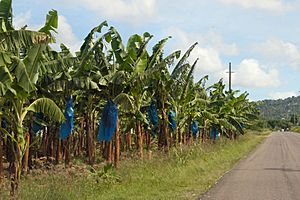Banana industry facts for kids
The banana industry is a huge part of how food is grown and sold around the world. It's a big business! About 15% of all bananas grown are sent to other countries. People in Western countries especially love to eat them. Most bananas come from large farms called banana plantations, mainly in the Americas.
Contents
How Banana Farming Affects the Environment
Growing lots of the same crop, like bananas, on huge farms is called a monoculture. This way of farming can really affect our planet.
Pesticides and Forests
Banana farms often use many chemicals called pesticides. These chemicals help keep bugs away. But they can also harm the environment. Growing bananas can also lead to deforestation, which means cutting down forests. This destroys natural homes for animals and plants.
Travel and Packaging
Bananas travel long distances to reach stores. This travel, along with all the plastic packaging used, creates a lot of pollution. This pollution is called a carbon footprint.
Bananas as a Popular Crop
Bananas are super popular! In the United States, people eat more bananas than apples and oranges combined. That's a lot of bananas!
The Cavendish Banana
There are many different kinds of bananas around the world. But most of the bananas you see in stores are the same type. This type is called the Cavendish banana. It's the main banana grown for big businesses.
How Banana Diseases Spread
Just like people, plants can get sick. A serious banana disease is called Tropical Race 4. Experts think this disease spreads around the world. It often travels on farm equipment that has dirty soil on it. This equipment is used by big farming companies.
Who Controls the Banana Business?
A few very large companies control a big part of the international banana trade. In 2013, five multinational fruit companies controlled 44% of all banana sales.
| Company | Country | Market share in 2013 [%] |
|---|---|---|
| Chiquita | U.S. | 13 |
| Fyffes | Ireland | 6 |
| Dole Food Company | U.S. | 11 |
| Fresh Del Monte Produce | U.S. | 12 |
| Noboa | Ecuador | 2 |
These big companies used to own many banana farms. But over time, they started buying more bananas from independent farmers. This means they own fewer farms themselves now. For example, Chiquita sold many of its farms in Central America.
Supermarkets and Power
Today, big supermarkets in places like the US and Europe have a lot of power. They buy huge amounts of bananas. Sometimes, they buy directly from farmers. This gives them more control over the banana supply chain.
Where Bananas Are Grown and Shipped
In 2016, the world produced 148 million tonnes of bananas and plantains. India and China grew the most bananas. Together, they produced 28% of the world's bananas.
Other big banana-growing countries include the Philippines, Ecuador, Indonesia, and Brazil.
| Country | Bananas | Plantains | Total |
|---|---|---|---|
|
|
29.1 | 29.1 | |
|
|
13.1 | 13.1 | |
|
|
5.8 | 3.1 | 8.9 |
|
|
6.5 | 0.6 | 7.1 |
|
|
7.0 | 7.0 | |
|
|
6.8 | 6.8 | |
|
|
2.0 | 3.5 | 5.5 |
|
|
1.2 | 4.3 | 5.5 |
|
|
0.6 | 3.7 | 4.3 |
|
|
0.09 | 4.0 | 4.1 |
|
|
3.8 | 0.3 | 4.1 |
|
|
113.3 | 35.1 | 148.4 |
| Source: FAOSTAT of the United Nations Note: Some countries produce statistics distinguishing between bananas and plantain production, but four of the top six producers do not, requiring comparisons using the total for bananas and plantains combined. | |||
In 2013, 20 million tonnes of bananas were shipped around the world. Ecuador and the Philippines were the top exporters. They shipped out 5.4 and 3.3 million tonnes, respectively. The Dominican Republic was the main exporter of plantains.


